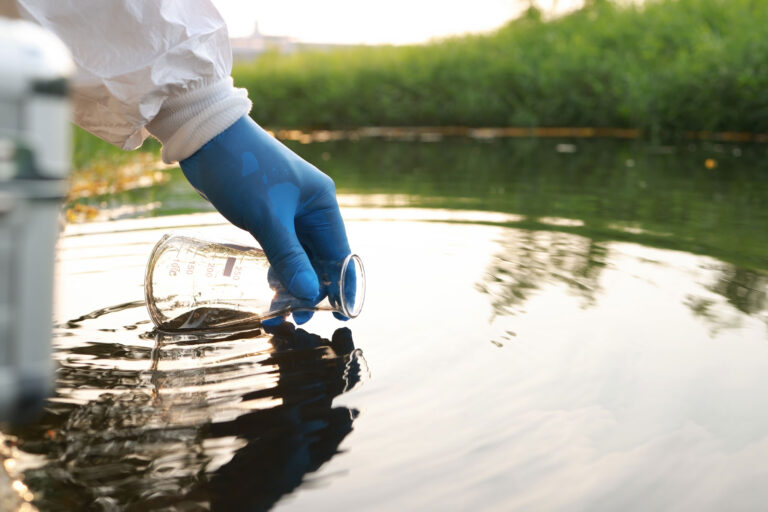Much has been made of two drinking water pollutants recently: PFAS and microplastics. We spoke with Jason Dadakis, executive director of water quality and technical resources with the Orange County Water District, to find out how worried we should be.

What are PFAS and microplastics, why are they in our water supply, and why should we care?
“PFAS” is an acronym for a large family of manmade chemicals that all feature the carbon-fluorine bond, one of the strongest bonds in nature.
They resist degradation in the environment, which is where they get their nickname “forever chemicals.” They’re used in firefighting foams, protective coatings and films, and consumer products like stain-resistant garments and carpets. They’re ubiquitous—they’re in things you touch, eat, and breathe. In fact, 99% of the population has detectable amounts of one or more of these substances in their blood. And they make their way into our water supplies and wastewater.
Individual PFAS are carcinogenic, but they can also cause deleterious non-cancer effects. Studies have shown negative health outcomes with low levels of chronic exposure. Given how widespread they are—and that they can occur in our drinking water—government regulators are stepping in.
“Microplastics” are manmade plastic particles, which the state of California defines as bigger than 1 nanonmeter and smaller than 5,000 micrometers. They enter the environment through human usage and disposal of plastic products. If you wash clothes in a washing machine with your nice, breathable synthetic fiber, for instance, it will likely shed microplastics into the sewer system.
In 2018, the California legislature passed SB 1422, which mandates that the State Water Board define microplastics and adopt a standard testing methodology. So far, it’s been tough. Testing methodologies aren’t very mature, and more research is needed on what exposure means in humans. The state will start collecting drinking water data next year.
How is the policy landscape changing?
In terms of microplastics and drinking water, California is pretty far ahead of the rest of the country.
In terms of PFAS, California has strict—though non-enforceable—advisory drinking water levels, or limits on PFAS concentrations in water. However, these are interpreted as enforceable regulations by most water utilities in the state. They are effectively a placeholder as the state board’s Division of Drinking Water works on developing enforceable PFAS regulations, which they’ll likely adopt in 2025.
At the federal level, the current administration has accelerated efforts to develop regulations and standards surrounding PFAS. There’s a lot of anticipation for a proposed national drinking water regulation that will go out for public comment early this year. The Environmental Protection Agency (EPA) intends to adopt a final regulation by the end of 2023; the federal Safe Drinking Water Act mandates that utilities comply with new requirements within three years of adoption.
What are practical ways to manage these contaminants in the water supply?
The best way to manage PFAS and microplastics is to start upstream and prevent them from getting into the water supply in the first place.
There are many policy avenues available. We need to scrutinize and limit the use of these chemicals in products, promote the concept of essential use, and aggressively look for alternatives. The state of California is starting to limit use and exposure, but there’s a ways to go.
Once these contaminants are in the water supply, it can be a challenge to manage them due to their persistence. Some established water treatment technologies work very well, such as adsorbents like granulated activated carbon and ion exchange resins. Nanofiltration and reverse osmosis are also good at removing or separating out PFAS, but they come with higher capital and operating costs. One emerging technology is “alternative absorbents”—a material with chemistry specifically modified so that it selectively absorbs more PFAS.
All these technologies remove and sequester PFAS, giving you very well-treated water, but also concentrated liquid or solid PFAS to manage. For solids, the traditional disposal technologies are landfill or incineration. Both methods face long-term sustainability challenges.
A lot of smart people are working on developing a viable, sustainable method to destroy PFAS. The Department of Defense is funding research looking at destructive technologies, because they’ve used PFAS-based firefighting foams all over the country and world for decades. These efforts have yielded some initial success at the lab and pilot scale when treating high concentrations of PFAS.
Anything else?
In Orange County, our water supplies have been affected by PFAS, and we face significant upfront capital costs and long-term operating costs to remove them. In the short term, we‘ve had to raise our rates to pay for these projects; fortunately we’ve received some federal financing assistance through the EPA. But ultimately, we don’t believe our ratepayers should be on the hook for this.
A couple of years ago, we filed a lawsuit against the original manufacturers, including 3M, Dupont, and others. In our view, this is where the liability lies. These companies knew about the adverse health effects of these chemicals for decades, but they continued to market and profit from them without disclosing the issues. The first bellwether trial for an impacted water utility is scheduled to start this summer in the federal multidistrict litigation created in South Carolina for PFAS cases. We are watching it closely: we, along with many other utilities, believe the original manufacturers should be liable for the problems they’ve caused across the country.





